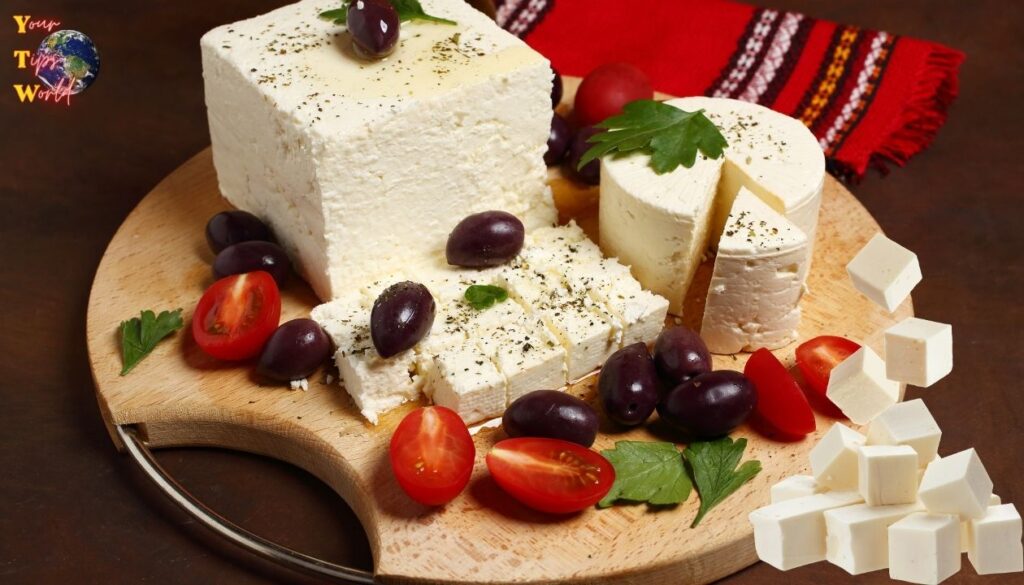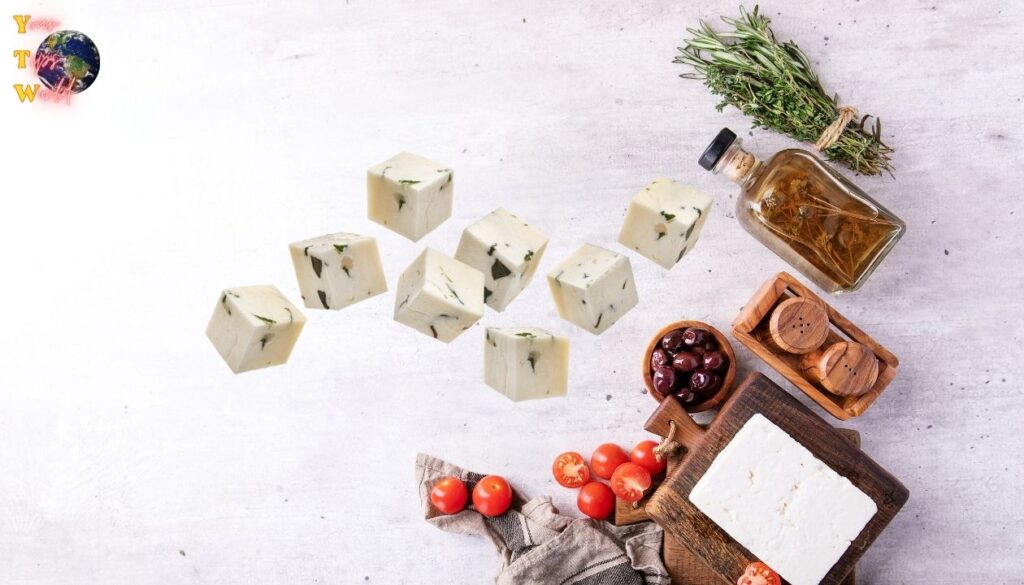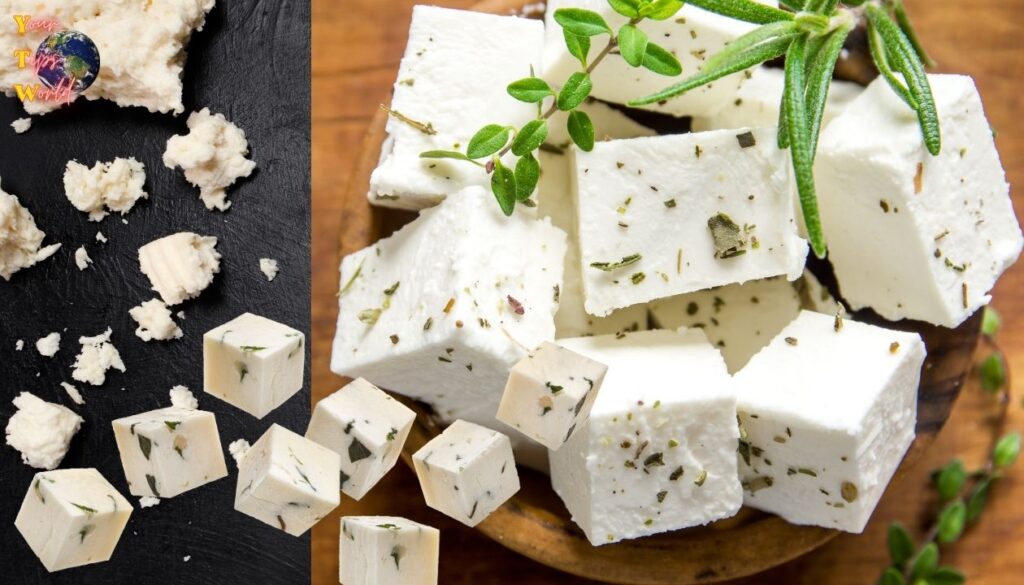Are you passionate about adding CHEESE to your culinary creations? If that is the case, Goat Feta Cheese should come as no surprise: its crumbly texture and unique flavor has earned its way into homes across the world as an indispensable culinary ingredient.
Feta cheese, known for its distinct combination of salty and tart notes, has become an indispensable staple in Mediterranean cuisine.
Goat feta adds an exciting new dimension to traditional recipes; whether or not you consider yourself an enthusiast of cheese, delving into this area will open up new culinary horizons for you using Goat Feta Cheese.
According to USDA, Goat Feta Cheese also has a great nutritional value.
In this article, we will investigate the crumbly texture of feta cheese as well as its varied variations including fresh and aged goat cheese varieties, the basics of homemade feta cheese production for beginners, pairing feta with other ingredients to form unique recipes and the wide array of goat feta variations available worldwide.
Join us as we embark on this flavorful culinary adventure of Goat Feta Cheese together and uncover its endless potential!
Exploring the Salty and Rich Flavors of Feta Cheese
Dating back almost 3,000 years, Goat Feta Cheese is an integral part of culinary history and tradition. Originally crafted with sheep milk, feta can also be made using goat or cow milk, offering a variety of flavors and textures.
Ranging from firm and crumbly to sumptuously creamy, this multifaceted cheese infuses salty and tangy notes into any dish it graces.
The versatility of feta lies in its ability to complement different textures and tastes. Feta crumbles can lift salads and flatbreads to new heights, while larger chunks offer a balance of richness and salinity that can transform the simplest of appetizers into exquisite treats.
Imagine a serving plate with ripe tomatoes, crunchy cucumbers, all dressed in extra virgin olive oil, sprinkled with herbs, and adorned with generous feta chunks—the resulting flavor harmony is a testament to feta’s alluring charm.
Particularly for those concerned with salt intake, goat milk feta emerges as a popular choice, featuring a handmade allure cultivated through natural and time-honored techniques.
The Crumbly Texture of Feta Cheese
Feta cheese, with its rich history dating back 3,000 years to the era of Homer’s Odyssey, is a treasure of culinary antiquity.
While traditionally crafted from sheep’s milk, modern feta may hail from goat, cow, or a blend, offering a spectrum of flavors and production flexibility.
It’s the salty, tangy bite of feta that captivates food lovers, embodying a texture that can range from a satisfying crumble to a lush creaminess.
Feta’s fame is not unwarranted, as it adds zest to salads and a sumptuous depth to baked dishes.
For authenticity, Greek feta insists on a precise recipe – sheep’s milk, with no more than 30% goat’s milk, establishing its singular taste.
The characteristic crumbly texture of feta is not just a delight to the palate but also to the eye, often serving as the crowning touch atop a culinary creation.
Consider the table below for a quick texture guide to feta cheese:
| Milk Source | Texture | Flavor Note |
| Sheep | Firm to crumbly | Rich, tangy |
| Goat | Softer, less crumbly | Milder, tangy |
| Cow | Creamier | Less intense |
| Mixed | Varied | Balanced complexity |
Regardless of the choice, feta’s crumbly nature makes it a beloved cheese, perfect for adding a pop of salty goodness to dishes.
Fresh and Aged Goat Cheese: Understanding the Differences

Fresh goat cheese and aged goat cheese are two distinct categories in the wide world of this dairy delight, each offering unique culinary experiences.
Fresh goat cheese, often known as chèvre, is noted for its soft, spreadable texture and is often enjoyed shortly after production.
It’s made by adding rennet and bacteria culture to warmed goat’s milk, which causes curds to separate from whey. This type of goat cheese does not undergo the aging process, thus, it retains a mild flavor and a creamy consistency.
Aged goat cheese requires at least one month and often several to fully mature before it can be sold commercially. As it matures, its texture becomes firmer while flavors intensify; its darkened rind gives an indication of maturity.
As opposed to fresh varieties, aged varieties bring bolder flavors and crumblier textures that enhance dishes of various cuisines.
Understanding these variations is vitally important to any food enthusiast or home chef as they can have a dramatic effect on the outcome of any dish they cook up.
Here is a basic comparison:
| Type | Texture | Flavor | Maturation |
| Fresh Goat Cheese | Soft & spreadable | Mild & creamy | No aging required |
| Aged Goat Cheese | Firmer & crumbly | Tangy & full-flavored | Aged 1 month or more |
Exploring the Varieties of Fresh Goat Feta Cheese
The cheese territories of France are particularly renowned for their expertise in crafting fresh goat cheese. Originating over a millennia ago in the fertile Loire River Valley, fresh goat cheese has since evolved into a range of varieties known as chèvre.
Each style of chèvre bears its unique characteristics, from the spreadable, light, and creamy Président® cheese, famed in the Poitou-Charentes region, to the more solid and textured varieties found across different regions.
In the United States, fresh goat cheese usually takes the form of a soft, fresh log that lends itself well to spreading over bread or crumbling into salads. Unlike feta, which is submerged in brine, fresh goat cheeses are presented without this saline solution, thus retaining their natural, mild creaminess.
Here are some popular varieties of fresh Goat Feta Cheese:
- Président®: Light, creamy, and rindless, perfect for a dairy-forward flavor.
- Valençay: Pyramid-shaped with a dusting of charcoal, slightly more textured.
- Chavroux: Soft and very spreadable with a delicate taste, excellent for dips.
The Unique Qualities of Aged Goat Feta Cheese
Aged goat cheeses bring complexity and depth to the cheeseboard. Crafted from hormone-free goat milk and devoid of preservatives, these artisanal cheeses are not only respected for their natural composition but also for their rich flavors.
As the cheese matures, the inherent tanginess and salty notes are enhanced, which can add a sophisticated element to dishes such as roasted vegetables or a pear and walnut salad.
With time, the crumbly texture becomes more pronounced in aged goat cheeses, which some cheese lovers find particularly appealing.
The darkening rind of these cheeses can be seen as both an aesthetic touch and a signpost of the cheese’s maturity, signaling to connoisseurs the exact stage of flavor development it has reached.
Some notable aged Goat Feta Cheese include:
- Crottin de Chavignol: Aged to a firm texture, perfect for grating over dishes.
- Gouda Goat Cheese: Offers a buttery, caramel-like flavor as it ages.
- Garrotxa: A semi-hard cheese with a velvety mold rind and complex flavors.
When selecting between fresh and aged Goat Feta Cheese, consider the desired taste and texture profile to perfectly complement your culinary creations.
Whether it’s the light creaminess of fresh goat cheese for a subtle enhancement or the bold character of an aged variety for a flavor statement, goat cheese promises versatility and delight for the palate.
Homemade Cheese: A Beginner’s Guide
Entry to homemade cheesemaking can be both thrilling and fulfilling culinary adventure, particularly for those attempting their first goat feta.
Feta cheese’s crumbly texture and unique yet tart taste profile makes it popular with gourmands and newcomers to cheese-making alike;
its relative ease in production also serves as an effective gateway into cheese-making for beginners.
The Basics of Making Homemade Goat Feta Cheese
Making feta cheese at home begins with sourcing the right kind of milk. Traditional Greek feta cheese typically uses sheep’s milk or a blend of sheep and goat’s milk, with goat’s milk not surpassing the 30% mark.
For those in the EU, feta is a cheese recognized under the Protected Designation of Origin (PDO), attributing to its quality assurance, which dictates the milk composition.
The cheese-making process includes warming the milk and introducing lactic acid starter cultures. These cultures work to separate the whey from the curds, sour the milk, and initiate fermentation—key steps in achieving feta’s distinctive taste.
With the addition of an enzyme known as rennet, the casein in the milk sets, leading to milk curd formation.
Once set, the curds are delicately cut into smaller cubes and transferred into molds. It is in these molds that the magic of transformation occurs, with the curds aging and developing feta’s trademark salty and tangy essence.
With no special equipment required, this process is an accessible entry point for homemade cheese enthusiasts.
Here’s a simple overview for making homemade Goat Feta Cheese:
- Warm the milk to the ideal temperature.
- Add lactic acid starter cultures to milk.
- Introduce rennet to set the casein.
- Cut the curds and place in molds.
- Age the curds to perfection.
Tips for Newbie Cheese Makers
Embarking on a cheese-making journey requires keen attention to detail, and a few practical tips can help ensure success. First and foremost, a cheese making kit tailored for goat cheese may provide all necessary components and instructions to help beginners get off to a good start.
Essential for homemade Goat Feta Cheese are ingredients like mesophilic direct-set starter culture, liquid vegetable rennet, and the appropriate cheese salt. These can typically be readily found online or at a local cheese-making supply store.
It’s equally critical to have the right brine, a solution of salt, calcium chloride, and filtered water. This not only preserves the cheese but also contributes to its flavor development.
For those without access to fresh sheep or goat milk, cow milk can be a substitute. However, it often requires the addition of lipase to replicate the characteristic flavor profile of feta. This enzyme is crucial when creating feta with cow milk.
Below is an essential beginner’s checklist for making feta:
- Direct-set starter culture
- Liquid vegetable rennet
- Cheese salt
- Salt for brine solution
- Calcium chloride (for brine)
- Filtered water (for brine)
- Lipase powder (if using cow milk)
- Whole goat milk or pre-mixed cow milk
With this knowledge, homemade Goat Feta Cheese is within your grasp. Whether you decide to stick with tradition or experiment with available variants of milk cheese, your journey toward becoming a proficient cheese maker is sure to bring delightful and delicious rewards.
The Perfect Complement: Pairing Goat Feta Cheese with Other Ingredients

Goat Feta Cheese’s distinctive taste and aroma make it a favorite for enhancing the flavors of a myriad of dishes. Its ability to pair wonderfully with a vast array of ingredients—spanning from juicy watermelon and fresh mint to ripe tomatoes, crisp peppers, and savory olives—creates memorable culinary experiences.
Feta’s versatility extends to its applicability as a topping for tacos, where it brings a creamy tanginess that’s hard to resist, or as a savory note within fluffy omelets.
Beyond these, feta adds a Mediterranean twist to pasta dishes when combined with artichokes, olives, and capers, infusing meals with a briny, aromatic profile.
Despite its creamy disposition, Goat Feta Cheese remains a healthy option low in calories and fat but high in flavor, allowing for guilt-free indulgence in a variety of dishes.
Here are some favorite pairings that showcase feta’s adaptable character:
- Watermelon and feta salad with fresh mint
- Greek salad with tomatoes, cucumbers, and olives
- Spinach and feta stuffed chicken breasts
- Mediterranean pasta with artichokes, olives, capers, and feta
- Feta-topped vegetarian tacos
Understanding the Role of Lipase in Goat Feta Cheese Production
At the heart of Goat Feta Cheese’s unique flavor spectrum is an often-overlooked ingredient: lipase. This enzyme plays a pivotal role in enhancing the nuanced flavors and aromas that feta is known for.
During the cheese-making process, lipase can be meticulously diluted and introduced to goat milk along with starter cultures and rennet, kickstarting the transformation into cheese.
The incorporation of lipase results in a wider spectrum of flavors, often contributing to a stronger, more characteristic profile that distinguishes feta from its counterparts.
This essential enzyme’s function does not stop at flavor augmentation—it also assists in achieving the cheese’s desired texture, serving as a vital component in the artisanal creation of feta.
While all feta possesses a tangy edge and a salty profile, the presence of lipase can calibrate these flavors to perfection.
Whether subtle or pronounced, this fundamental ingredient is indispensable in crafting the cheese’s distinctiveness, making it an integral aspect of feta cheese production that aficionados deeply appreciate.
Summary: Delving into the Richness of Goat Feta Cheese
Goat feta cheese is a diversified delight in the world of cheeses, known for its crumbly texture and rich, salty flavor. Produced mostly from pasteurized goat milk, this fresh cheese stands out with its tangy taste profile and can be aged to enhance its depth.
With variants ranging from young, creamy types to mature, aged versions, goat feta adds a robust touch to dishes.
| Milk Source | Texture | Flavor | Age |
| Goat Milk | Crumbly | Salty, Rich | At least 6 days |
| Sheep Milk (up to 30%) | Smooth to Mature | Tangy, Distinct | 3 months+ |
Notable for its versatility, goat feta cheese is a perfect complement for salads, an ideal addition to summer dishes, and an enriching component in savory bakes.
Enthusiasts appreciate the meticulous artistry behind its creation, which involves a careful process from the coagulation of milk to the aging in brine solution.
In summary, whether you’re a seasoned cheese lover or a newbie cheese maker, exploring homemade Goat Feta Cheese tonight or sampling batches of commercially-produced cheese, goat feta offers a medley of both subtle and assertive notes that cater to a variety of palates and preferences.
